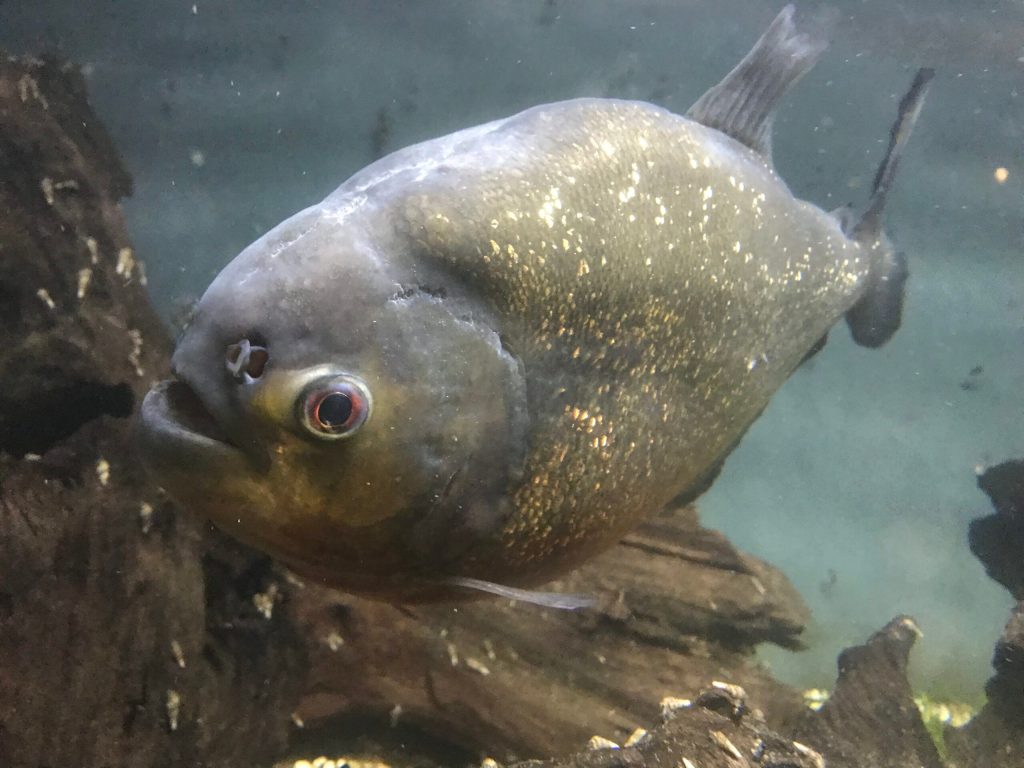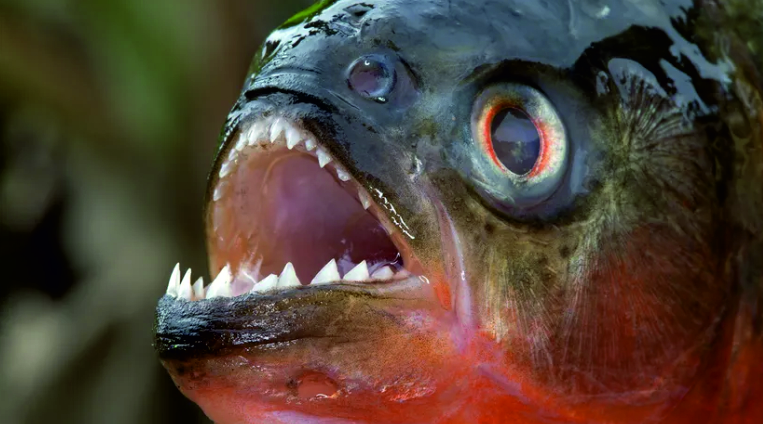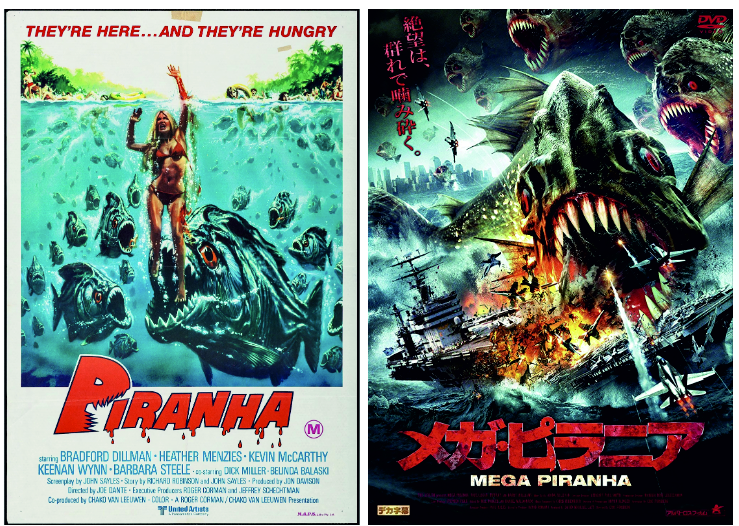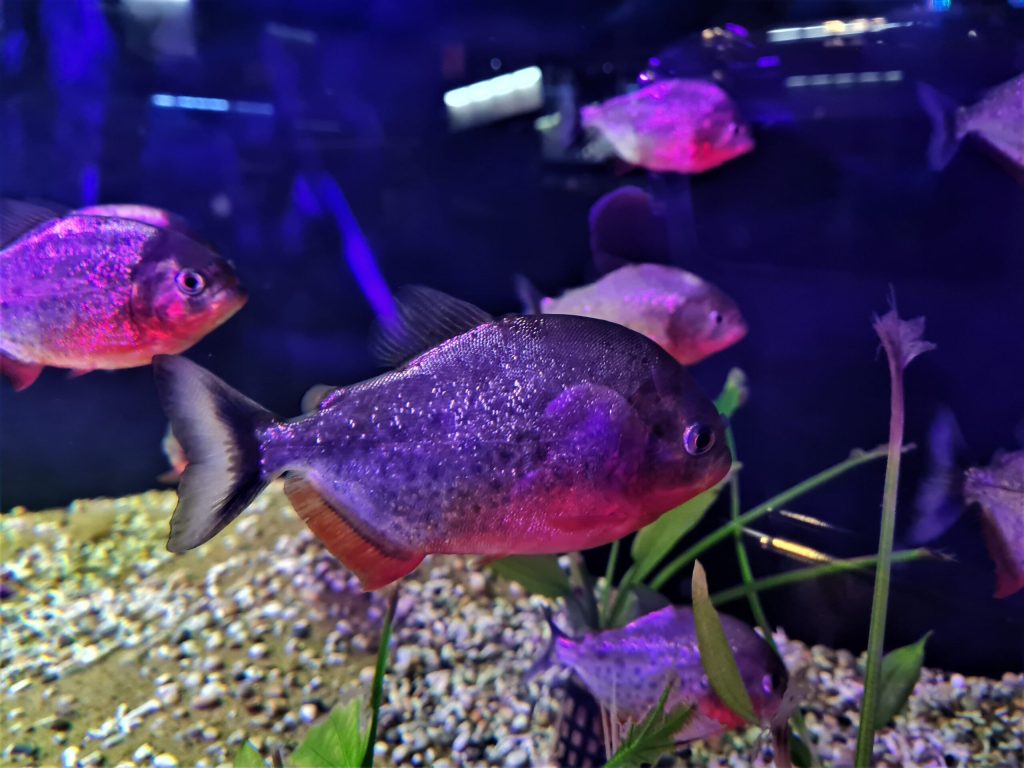PIRANHA!
Piranha: The Fish, The Myth, The Legend
Have you managed to spot one of our baby red-bellied piranha? If so, you’re quite lucky! They’re incredibly shy at the moment and spend most of their time hidden away! To say they’re more scared of you than you are of them would be absolutely true! Seeing these little guys makes you wonder how on earth piranha have been the subject of horror films for decades, so let’s dive in and figure out just why people are so scared of these sweet little creatures.

Who, What, Where?
The word Piranha originates from the Tupi language, spoken by the indigenous Tupi people of Brazil. It is thought to literally mean ‘biting-fish’. The name refers to a range of toothed, freshwater fish species, all of which are endemic to South American rivers, lakes, floodplains and reservoirs. The most well known and common species (and the ones we have here at Plantasia!) are red-bellied piranha, which are found primarily in the Amazon river, as well as the coastal rivers of north-eastern Brazil.
While relatively small (red-bellies can grow up to 50cm), piranha possess among the strongest bites of all bony fish, and some species like the black piranha may rival even the strongest vertebrate bite forces! Crikey! These incredible jaws, lined with a single row of interlocking, serrated teeth mean that piranha are built for ripping and tearing, which does NOT do wonders for their public image!

Image via https://animals.howstuffworks.com/fish/piranha.htm
Their reputation as a ferocious, man-eating predator that can strip someone to mere bone in seconds precedes them. Despite this, piranha are typically very timid, opting instead to avoid large animals and humans that may wander into their homes. There has been only ONE proven fatal piranha attack, which can be linked to poor conditions for the piranha such as lower water levels and increased piranha density, which of course decreases the availability of food!
So, why such a bad rep?
The first thing we think of may be Hollywood B-movies, but their ravenous reputation can be traced all the way back to former US President Theodore Roosevelt! In 1913, the big-game hunter embarked on an expedition to Brazil, whereupon he paid visit to an unnamed tributary of the Aripuana River (which would later be named Rio Theodore Roosevelt, in his honour). Here, the Tupi people slaughtered a cow before pushing it into the river, what followed was pure carnage as hundreds of piranha swarmed the carcass, reducing it to bone in minutes. Roosevelt would go on to write about this experience in his bestselling 1914 book Through the Brazilian Wilderness, wherein he refers to piranha as “the most ferocious fish in the world”.
What ol’ Teddy did not know, however, was that the event was entirely staged by the locals, who had gathered hundreds of piranha in the weeks prior to the visit, storing them in a netted-in section of the river without access to food, effectively starving the piranha to elicit a more voracious display from the fish. It is believed this was done to satisfy the American’s lust for excitement, as well as possibly to pull a trick on the outside world. Despite that, Roosevelts grisly account would grant piranha the notoriety of one of the most feared fish in the world, second perhaps to only sharks! And just like sharks, this grim prestige would go on to be exploited by Hollywood ad nauseam.
The Sons of Jaws

Images via https://www.etsy.com/uk/listing/1359601332/piranha-united-artists-1978-retro-movie and https://www.cinematerial.com/movies/mega-piranha-i1587807/p/ovm9zqb4
We’ve all heard of Spielberg’s iconic film Jaws! Released in 1974, it brought creature-feature exploitation to the mainstream, what would have previously occupied B-movie status now had real prominence with movie-goers! And of course, many were eager to ride the coattails (or perhaps dorsal fin) right up to the top! This inspired many similar movies, including Joe Dante’s 1978 Piranha, a playful homage in itself.
Dante’s third film sees genetically modified piranha voraciously attacking people in all sorts of unlikely locations, until the final act where the freaky fish unleash havoc at a holiday resort! While not quite as memorable as Jaws, Piranha itself went on to inspire many films with increasingly ridiculous portrayals of the timid toothed fish. Ranging from astronomically sized mega-piranha taking down battleships, to swarms terrorising everywhere from suburban swimming pools, to packed beaches, and even your own toilet! Truly, nowhere is safe, or so these films would have you believe! In reality, there is only one anecdotal report of a fatal piranha attack on Paraguayan soldiers in 1870, and absolutely no confirmed reports of a fatal attack on large animals since.
The Fish Are Alright?
You got it! Piranha aren’t maneaters at all! They are in fact omnivores, meaning they’ll eat vegetation in and around the water too, just like their close cousins the Pacu, which look very similar, but are entirely herbivorous. In fact, in South America, you’re more likely to eat a piranha than have a piranha eat you! They are a fairly popular food when grilled or baked, however, the local fisherman see them as more of a nuisance, known for stealing bait, eating catches, and giving the fishermen the occasional nip! Those teeth are put to good use by tribespeople of the Camayura and Shavante in Brazil, where they are used as tools for carving wood or cutting hair!
It’s important to keep in mind that piranha are incredibly lucky to still be found in such abundance! Such a poor reputation can and has had devastating consequences for populations of other creatures, most notably, sharks. Since the release of Jaws in ‘74, Sharks have been continuously and ruthlessly maligned in the media, in a phenomenon now referred to as ‘Sharksploitation’. As a near direct result, shark populations around the world have declined by up to 98% in some species such as the oceanic whitetip. Fishermen and even the average person often see these animals as maneaters, leading to illegal hunting and culls, in addition to those killed in bycatch and for shark-finning industries, Jaws has been an unprecedented disaster for the global shark population!
A bad rep isn’t the only thing that threatens piranhas, with their home waterways facing increasing pollution, primarily as a result of forest clearance for agriculture, increased industrial operations, and wildfires, which are becoming increasingly common due to climate change. In addition to this, plastic pollution is proving to be a huge detriment to the health of 80% of species in the Amazon river, with microplastic fragments being found in fish muscle and stomachs. With the small sizes of these particles and their resilience to degradation, it’s likely that some of these particles have come from half the world away, though most of it is dumped locally. Plastic pollution affects not just piranha and other Amazonian fish, but marine populations everywhere in the world, as well as the animals and people that rely on these populations for food!
At the end of the day, piranha are just like any other fish, trying to live peacefully in their rivers, and will only give you a nip if you’re bothering them! Thankfully, their poor reputation with the public hasn’t affected their population numbers, and are still among the most common fish in their habitat! So, next time you see our famous toothy baby buddies swimming around in Plantasia, remember that the movies are just that, movies!

by Zoology Year-In-Industry student Jude Vaughan from Swansea University
